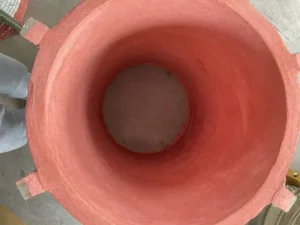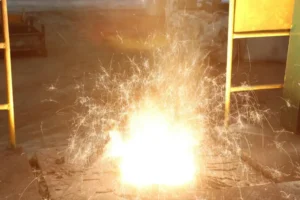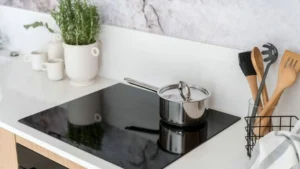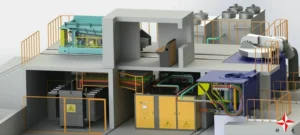ระบบทำความเย็นเป็นสิ่งสำคัญสำหรับเตาหลอมเหนี่ยวนำ, เนื่องจากมีความร้อนสูงระหว่างการทำงาน. หากความร้อนนี้ไม่กระจายออกไปอย่างมีประสิทธิภาพและทันท่วงที, มันอาจทำให้เกิดความร้อนสูงเกินไป, ซึ่งจะทำให้ประสิทธิภาพลดลง, อายุขัยสั้นลง, ทำให้อุปกรณ์เสียหาย, หรือแม้กระทั่งทำให้เกิดอันตรายต่อความปลอดภัย.
ความสำคัญของระบบทำความเย็น
ระบบทำความเย็นเตาเหนี่ยวนำใช้เป็นหลักเช่นกัน ระบายความร้อนด้วยน้ำ หรือ อากาศเย็น, และบางครั้งก็เป็นทั้งสองอย่างรวมกัน.
- มั่นใจในการใช้งานอุปกรณ์ที่ปลอดภัย: อุณหภูมิสูงเป็นอันตรายต่อทั้งอุปกรณ์อิเล็กทรอนิกส์และอุปกรณ์เครื่องกล. ส่วนประกอบสำคัญในเตาเหนี่ยวนำ, เช่น ขดลวดเหนี่ยวนำ และไทริสเตอร์, สร้างความร้อนอย่างมากเมื่อใช้งาน. อุณหภูมิที่มากเกินไปสามารถทำลายส่วนประกอบเหล่านี้ได้โดยตรง, อาจนำไปสู่เพลิงไหม้หรือการระเบิดได้. ระบบระบายความร้อนช่วยขจัดความร้อนนี้ได้อย่างมีประสิทธิภาพ, รักษาอุปกรณ์ให้อยู่ในอุณหภูมิการทำงานที่ปลอดภัย.
- การยืดอายุการใช้งานของอุปกรณ์: การทำงานต่อเนื่องที่อุณหภูมิสูงจะช่วยเร่งการเสื่อมสภาพของส่วนประกอบ, ลดอายุการใช้งานของอุปกรณ์. ระบบระบายความร้อนที่แข็งแกร่งช่วยควบคุมอุณหภูมิของอุปกรณ์, ชะลอการเสื่อมสภาพของส่วนประกอบและช่วยยืดอายุการใช้งานโดยรวมของเตาเหนี่ยวนำ.
- การปรับปรุงประสิทธิภาพการผลิต: อุณหภูมิการทำงานที่มั่นคงช่วยให้เตาเหนี่ยวนำสามารถรักษาประสิทธิภาพการทำความร้อนได้อย่างมีประสิทธิภาพ. หากการระบายความร้อนไม่เพียงพอทำให้เกิดการปิดเครื่องเนื่องจากความร้อนสูงเกินไปบ่อยครั้ง, มันสามารถส่งผลกระทบอย่างรุนแรงต่อประสิทธิภาพการผลิต.
- การอนุรักษ์พลังงาน: ระบบระบายความร้อนที่มีประสิทธิภาพสามารถลดการสูญเสียความร้อนและปรับปรุงการใช้พลังงานได้. ตัวอย่างเช่น, ระบบระบายความร้อนด้วยน้ำแบบวงปิดบางระบบสามารถรีไซเคิลน้ำหล่อเย็นได้, ลดการใช้น้ำ.
วิธีการทำความเย็นแบบต่างๆ: บทนำและการบำรุงรักษา
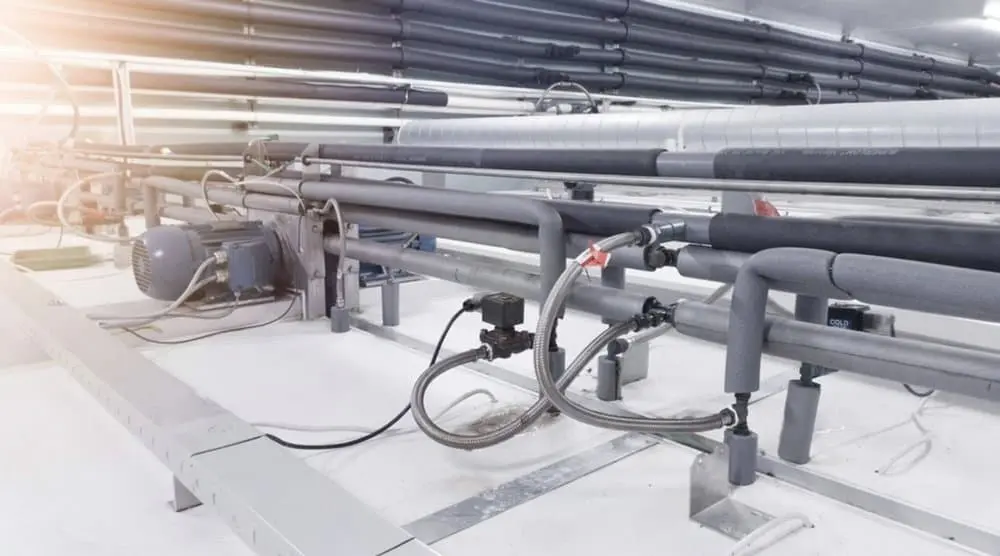
ระบบน้ำหล่อเย็น
ระบายความร้อนด้วยน้ำ เป็นวิธีระบายความร้อนที่ใช้กันมากที่สุดสำหรับเตาเหนี่ยวนำ, โดยเฉพาะอย่างยิ่งสำหรับหน่วยกำลังสูง, เนื่องจากสามารถกระจายความร้อนได้อย่างมีประสิทธิภาพสูง.
การแนะนำ
โดยทั่วไประบบระบายความร้อนด้วยน้ำจะหมุนเวียนน้ำหล่อเย็นเพื่อขจัดความร้อนออกจากส่วนประกอบที่ร้อน เช่น คอยล์เหนี่ยวนำ, ไทริสเตอร์, และตัวเก็บประจุ. หลักการนี้อาศัยความจุความร้อนจำเพาะสูงของน้ำและค่าการนำความร้อนที่ดี. ปั๊มหมุนเวียนน้ำหล่อเย็นผ่านช่องทางในส่วนประกอบที่ให้ความร้อน. น้ำจะดูดซับความร้อน, อุณหภูมิของมันสูงขึ้น, จากนั้นจะปล่อยความร้อนนี้ออกสู่สิ่งแวดล้อมผ่านอุปกรณ์เช่นหอทำความเย็น, ชิลเลอร์, หรือเครื่องแลกเปลี่ยนความร้อน. จากนั้นน้ำเย็นจะถูกหมุนเวียนซ้ำ.
ข้อดีของระบบน้ำหล่อเย็น
- ประสิทธิภาพการกระจายความร้อนสูง: น้ำนำความร้อนได้ดีกว่าอากาศมาก, ช่วยให้สามารถขจัดความร้อนปริมาณมากได้อย่างรวดเร็วและมีประสิทธิภาพ, ทำให้เหมาะกับอุปกรณ์กำลังสูง.
- การควบคุมอุณหภูมิที่แม่นยำ: การควบคุมอุณหภูมิที่แม่นยำทำได้ง่ายกว่า, รักษาอุปกรณ์ให้อยู่ในช่วงอุณหภูมิการทำงานที่เหมาะสมที่สุด.
- รอยเท้าค่อนข้างเล็ก: เมื่อเทียบกับระบบระบายความร้อนด้วยอากาศที่มีความสามารถในการกระจายความร้อนเทียบเท่า, อุปกรณ์ระบายความร้อนด้วยน้ำโดยทั่วไปจะมีขนาดกะทัดรัดกว่า.
ข้อเสียของระบบน้ำหล่อเย็น
- ต้องใช้น้ำ แหล่งที่มา: อาศัยแหล่งน้ำและต้องใช้อุปกรณ์เสริม เช่น เครื่องสูบน้ำ, ท่อ, หอทำความเย็น, หรือชิลเลอร์.
- ความเสี่ยงจากการรั่วไหลที่อาจเกิดขึ้น: ท่อ, ข้อต่อ, และส่วนประกอบอื่นๆ มีความเสี่ยงที่จะเกิดการรั่วซึม, ซึ่งอาจทำให้อุปกรณ์เสียหายได้หากเกิดขึ้น.
- ข้อกำหนดด้านคุณภาพน้ำ: คุณภาพน้ำหล่อเย็นส่งผลกระทบอย่างมากต่อการทำงานของระบบ. ปัญหาต่างๆ เช่น การสะสมของตะกรันและการกัดกร่อนอาจทำให้เกิดการอุดตันและลดประสิทธิภาพการกระจายความร้อนได้.
- การป้องกันการแช่แข็งในฤดูหนาว: ในเขตหนาว, จำเป็นต้องมีมาตรการป้องกันการแข็งตัวในช่วงฤดูหนาวเพื่อป้องกันไม่ให้น้ำหล่อเย็นแข็งตัวและทำให้ท่อและอุปกรณ์เสียหาย.
การซ่อมบำรุง ของระบบน้ำหล่อเย็น
- การจัดการคุณภาพน้ำ: ทดสอบคุณภาพของน้ำหล่อเย็นอย่างสม่ำเสมอ, รวมถึงค่า pH, ความแข็ง, และปริมาณคลอไรด์. เติมสารบำบัดน้ำตามความจำเป็นเพื่อป้องกันการเกิดตะกรัน, การกัดกร่อน, และการเจริญเติบโตของจุลินทรีย์. แนะนำให้ใช้น้ำบริสุทธิ์หรือน้ำปราศจากไอออน.
- การทำความสะอาดเป็นประจำ: ทำความสะอาดท่อทำความเย็นเป็นระยะ, หม้อน้ำ, ตัวกรอง, และหอหล่อเย็นเพื่อกำจัดตะกรัน, สิ่งสกปรก, และสิ่งสกปรก, ทำให้มั่นใจได้ถึงการไหลของน้ำที่ราบรื่นและปรับปรุงประสิทธิภาพการกระจายความร้อน.
- การตรวจสอบการรั่วไหล: ตรวจสอบท่อน้ำทั้งหมดอย่างสม่ำเสมอ, ข้อต่อ, วาล์ว, และปั๊มสำหรับการรั่วไหล, ระบุและแก้ไขปัญหาใด ๆ ได้ทันที.
- มาตรการป้องกันการแช่แข็ง: ก่อนฤดูหนาว, ใช้มาตรการป้องกันการแข็งตัวที่จำเป็นตามอุณหภูมิในท้องถิ่น, เช่นการเติมสารป้องกันการแข็งตัว, ระบายน้ำหล่อเย็น, หรือทำให้ปั๊มหมุนเวียนทำงานต่อไป.
- การตรวจสอบปั๊มและวาล์ว: ตรวจสอบสถานะการทำงานของปั๊มน้ำหล่อเย็นอย่างสม่ำเสมอ, รวมถึงเสียงรบกวนด้วย, การสั่นสะเทือน, และปัจจุบัน, เพื่อให้แน่ใจว่ามีการทำงานที่เหมาะสม. ตรวจสอบว่าวาล์วมีความยืดหยุ่นและเชื่อถือได้.
- การตรวจสอบอุณหภูมิและการไหล: ตรวจสอบอุณหภูมิทางเข้าและทางออกและอัตราการไหลของน้ำหล่อเย็นเพื่อให้แน่ใจว่าอยู่ภายในช่วงปกติ. ระบบน้ำหล่อเย็นของเตาความถี่ปานกลางควรมีอุปกรณ์แจ้งเตือนสำหรับอุณหภูมิทางออกและความแตกต่างในการไหลของทางเข้า/ทางออก, เชื่อมต่อกับแหล่งจ่ายไฟความถี่กลางเพื่อป้องกันอุปกรณ์เสียหายเนื่องจากการระบายความร้อนไม่เพียงพอ.
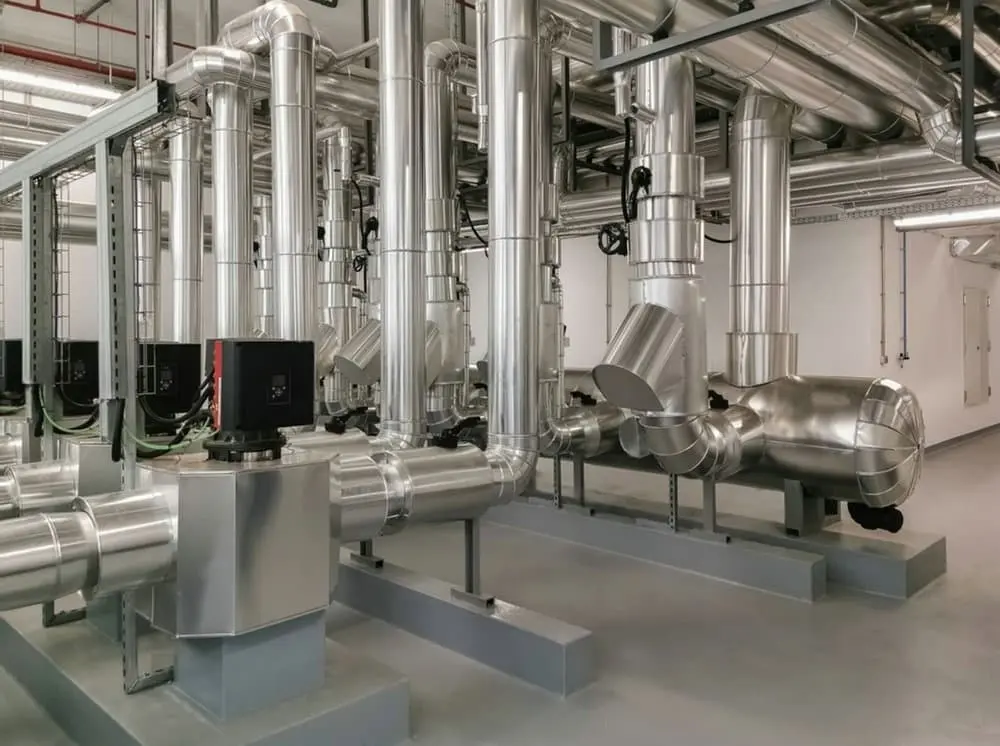
ระบบระบายความร้อนด้วยอากาศ
ระบายความร้อนด้วยอากาศ ระบบใช้อากาศเป็นตัวกลางในการระบายความร้อนเพื่อกระจายความร้อน. วิธีนี้ใช้ในเตาแม่เหล็กไฟฟ้าขนาดเล็กหรือเตาที่มีข้อกำหนดการกระจายความร้อนที่เข้มงวดน้อยกว่า, หรือเป็นส่วนเสริมของระบบหล่อเย็นด้วยน้ำ.
การแนะนำ
โดยทั่วไประบบระบายความร้อนด้วยอากาศจะใช้พัดลมเพื่อบังคับการไหลเวียนของอากาศเหนือแผงระบายความร้อนของส่วนประกอบที่ร้อน, พัดพาความร้อนออกไป. อากาศดูดซับความร้อน, อุณหภูมิของมันสูงขึ้น, แล้วมันก็ถูกไล่ออกสู่สิ่งแวดล้อมโดยตรง.
ข้อดีของ ระบายความร้อนด้วยอากาศ ระบบ
- โครงสร้างที่เรียบง่าย: โดยปกติต้องใช้เฉพาะพัดลมและตัวระบายความร้อนเท่านั้น, ทำให้โครงสร้างค่อนข้างเรียบง่าย, ติดตั้งง่าย, และรักษา.
- ไม่มีความเสี่ยงจากการรั่วไหล: ไม่ใช้น้ำเป็นตัวกลางในการทำความเย็น, ขจัดปัญหาการรั่วซึม.
- ต้นทุนค่อนข้างต่ำกว่า: การลงทุนเริ่มแรกและต้นทุนการดำเนินงานโดยทั่วไปจะต่ำกว่าระบบระบายความร้อนด้วยน้ำ.
- เป็นมิตรกับสิ่งแวดล้อม: ไม่ก่อให้เกิดมลพิษทางน้ำและไม่ต้องการการใช้น้ำเพิ่มเติม.
ข้อเสียของ ระบายความร้อนด้วยอากาศ ระบบ
- ประสิทธิภาพการกระจายความร้อนลดลง: ค่าการนำความร้อนของอากาศต่ำกว่าน้ำ, ส่งผลให้ประสิทธิภาพการกระจายความร้อนลดลง, ทำให้ไม่เหมาะกับอุปกรณ์กำลังสูง.
- ได้รับผลกระทบอย่างมากจากอุณหภูมิแวดล้อม: ประสิทธิภาพการกระจายความร้อนได้รับอิทธิพลอย่างมากจากอุณหภูมิโดยรอบและการไหลของอากาศ.
- เสียงรบกวน: พัดลมสร้างเสียงรบกวนระหว่างการทำงาน; พัดลมกำลังสูงก็ค่อนข้างดัง.
- การสะสมของฝุ่น: แผงระบายความร้อนสามารถสะสมฝุ่นได้ง่าย, ซึ่งส่งผลต่อประสิทธิภาพการกระจายความร้อนและต้องทำความสะอาดเป็นประจำ.
การบำรุงรักษาระบบระบายความร้อนด้วยอากาศ
- การทำความสะอาดเป็นประจำ: ทำความสะอาดฝุ่นและเศษซากจากตัวระบายความร้อนและใบพัดลมเป็นระยะๆ เพื่อให้มั่นใจว่าการไหลเวียนของอากาศจะราบรื่นและปรับปรุงประสิทธิภาพการกระจายความร้อน.
- การตรวจสอบการทำงานของพัดลม: ตรวจสอบสถานะการทำงานของพัดลมอย่างสม่ำเสมอ, รวมถึงเสียงรบกวนด้วย, การสั่นสะเทือน, และความเร็ว, เพื่อให้แน่ใจว่าทำงานได้อย่างถูกต้อง. ที่อยู่หรือเปลี่ยนทันทีหากพบความผิดปกติ.
- การตรวจสอบเส้นทางการระบายอากาศ: ตรวจสอบให้แน่ใจว่าช่องอากาศเข้าและทางออกของอุปกรณ์ไม่ถูกปิดกั้น, รักษาการระบายอากาศที่ดี.
- การควบคุมสิ่งแวดล้อม: พยายามรักษาสภาพแวดล้อมการทำงานของอุปกรณ์ให้สะอาดและระบายอากาศได้ดี, หลีกเลี่ยงอุณหภูมิสูงและความชื้นสูง.
- การตรวจสอบอุณหภูมิ: ตรวจสอบอุณหภูมิของส่วนประกอบที่สำคัญเพื่อให้แน่ใจว่าอยู่ภายในขีดจำกัดการออกแบบ.
บทสรุป
ไม่ว่าจะ ระบายความร้อนด้วยน้ำ หรือ อากาศเย็น ถูกนำมาใช้, ระบบทำความเย็นสำหรับเตาเหนี่ยวนำมีความสำคัญอย่างยิ่ง. การเลือกวิธีการทำความเย็นขึ้นอยู่กับปัจจัยต่างๆ เช่น กำลังของเตาเหนี่ยวนำ, สถานการณ์การใช้งาน, สภาพแวดล้อม, และงบประมาณ. อย่างไรก็ตาม, โดยไม่คำนึงถึงวิธีการทำความเย็นที่เลือก, การบำรุงรักษาและการตรวจสอบอย่างสม่ำเสมอ มีความสำคัญอย่างยิ่งต่อการรับประกันการดำเนินงานที่มีประสิทธิภาพและมีเสถียรภาพ. การละเลยการบำรุงรักษาระบบทำความเย็นไม่เพียงแต่ทำให้อายุการใช้งานของอุปกรณ์สั้นลงและเพิ่มค่าใช้จ่ายในการซ่อมแซม แต่ยังก่อให้เกิดอันตรายด้านความปลอดภัยอีกด้วย, ส่งผลกระทบต่อการผลิตอย่างรุนแรง. ดังนั้น, ธุรกิจควรจัดทำและปฏิบัติตามแผนการบำรุงรักษาระบบทำความเย็นอย่างครอบคลุมอย่างเคร่งครัด.


